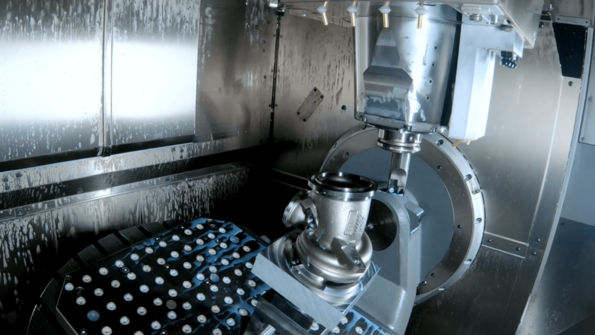Tebis brings interpolation turning to the market to offer easier access to the world of combined turning and milling
Martinsried, Germany, September 10, 2024 – End-to-end automated processes are more important than ever in the manufacturing industry. Tebis Version 4.1 Release 8 has been enhancing flexibility in automation like never before. In addition to turn-milling and mill-turning, Tebis 4.1 Release 8 also supports interpolation turning, which enables the easy and cost-effective production of rotationally symmetrical areas on many milling machines. Combined turn-milling can be used to perform turning and milling operations end-to-end on a single machine without reclamping. This combined approach is highly efficient, reduces throughput time and drastically cuts costs.
Tebis is also the only CAD/CAM system that offers 6-sided simultaneous interpolation turning.
Tebis is also the only CAD/CAM system that offers 6-sided simultaneous interpolation turning.
Tebis Key Account Manager Christoph Brückner explains:
The relatively new manufacturing method of interpolation turning is very popular. It enables turning on all machines that have a position-controlled spindle, including milling machines. This method is especially appropriate for parts with many milled elements and fewer turned elements. Time savings of up to 80 percent can be achieved with interpolation turning, because areas that previously had to be milled can now be turned.
It also allows the use of simple turning tools that have a long tool life instead of high-cost ground milling tools. Because the cutter is in continuous contact in interpolation turning, very high surface qualities are achieved.
Tebis is the only system on the market that’s mastered the next developmental stage of interpolation turning – namely, 6-axis simultaneous interpolation turning.
In addition to turn-milling and mill-turning, Tebis Version 4.1 Release 8 has now added interpolation turning to the mix
"With 6-axis simultaneous interpolation turning, even undercut areas can be manufactured easily and efficiently in a single setup," says Jakub Dittmar, Product Manager at Tebis. "Because very short tools can be used in multi-axis turning and the spindle interpolates very smoothly, this type of machining gives us an even better surface quality. It’s therefore the ideal technology when precision is foremost. We’ve already applied for a patent in Europe for this extremely promising and modern method."
Combined turn-milling as an introduction to an expanding product portfolio
Nearly all industry sectors manufacture parts that require turning and/or milling operations. They include the aerospace industry, the energy sector, medical technology and the automotive and semiconductor industries.
Due to its versatile solutions with turn-mill, mill-turning and interpolation turning, Tebis is the perfect solution for companies that want to increase their manufacturing capabilities.
Learn more at
Tebis optimally prepares companies for all the challenges of combined turning/milling
The Tebis solution: In Tebis, all toolpaths are safely checked for collisions, accounting for all traverse movements and machine components. No additional software is needed. The part can therefore be manufactured on the machine nearly fully automatically and unattended.
The "expertise" challenge: Employees lack programming and manufacturing knowledge. The Tebis solution: All programming tasks, whether milling or turning, can be completed end-to-end in a single application and with identical user guidance in Tebis. This drastically reduces training time. Many programming tasks can also be automated.
The "quality" challenge: The applications for combined turn-milling parts often place very high demands on surface quality.
The Tebis solution: With 6-axis simultaneous interpolation turning, the part is manufactured in a single pass with no change in tilt direction and therefore with no steps. Tebis fully supports the tight tolerances required in turning. Tebis simultaneously probes the surfaces during milling. NC point distribution can also be specifically controlled. This means that additional NC points can be placed in sensitive transition areas.
The "deformation" challenge: For example, for soft materials or thin-walled geometries.
The Tebis solution: Cutting data can be stored with virtual tools in Tebis for all materials and machining types. The toolpaths precisely match the machine’s capabilities.
The "tool breakage" challenge: Enormous forces act on the tool in turning. The Tebis solution: Maximum tool life can be specified for tools in Tebis. When the tool reaches the end of its lifespan, it’s is automatically replaced. As an alternative, a measuring program can also be directly generated for the tool. The measuring program is run on the machine, and the tool is automatically exchanged with its twin tool when necessary.



